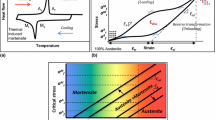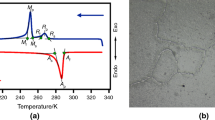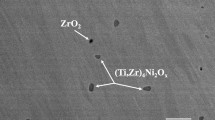Abstract
Shape memory alloys are used in diverse fields. It is Ni–Ti alloys that are predominantly used for applications capitalizing on the functional properties of shape memory and superelastic effect. These properties are influenced by factors, such as alloy composition, alloying addition, thermal and mechanical treatment, etc. In any application, the transformation temperatures of the alloy/device are very critical. Moreover, the stability of transformation temperatures and a smaller hysteresis are preferred. Ni–Ti alloys have their own limitations, such as low transformation temperatures and lack of ductility. In order to overcome these limitations, researchers have used ternary additions, such as Zr, Hf, Cu, Pd and Au. The use of copper is practicable because of its lower cost as compared to Ti and Ni. Substitution of Cu for Ni up to ~ 25% in an equiatomic NiTi alloy causes it to exhibit SME. The transformation temperatures of NiTiCu exhibit less sensitivity to composition and a smaller thermal hysteresis. In this work, therefore, the effect of methods of quenching on transformation temperatures and microstructure of an Ni–Ti–4Cu (at.%) alloy has been explored. The material was cast using vacuum induction melting. It was solutionized at 950 °C for 2 h and cooled using different methods/quenchants: liquid nitrogen, water at room temperature, air, annealing (furnace cooling). The samples quenched by different techniques were characterized by XRD, DSC, OM, SEM and hardness test. The results indicated that the martensite plate size varied in samples quenched using different quenchants even though the morphology was the same in all specimens. In addition, the transformation temperatures and hardness values of the alloy specimens varied as the intensity of quenching varied. The results are presented and discussed in detail in the paper.






Similar content being viewed by others
References
Wayman C M, MRS Bull.18 (1993) 49.
Otsuka K, and Wayman C M, Shape Memory Materials, Cambridge University Press, Cambridge (1998).
Jani J M, Leary M, Subic A, and Gibson M A, Mater. Des.56 (2014) 1078.
Zarinejad M, and Liu Y, Adv. Funct. Mater.18 (2008) 2789.
Otsuka K, and Ren X, Prog. Mater. Sci.50 (2005) 511.
Liu Y, in Shape Memory Alloys, (ed) Chen H R, Nova Science Publishers Inc., New York (2010), p 361.
Mahmud A, Wu Z, Zhang J, Liu Y, and Yang H, Intermetallics103 (2018) 52.
Chen Y, Tyc O, Kadeřávek L, Molnárová O, Heller L, and Šittner P, Mater. Des.174 (2019) 1.
Frenzel J, Wieczorek A, Opahle I, Maaß B, Drautz R, and Eggeler G, Acta Mater.90 (2015) 213.
Bozzolo G, Noebe R D, and Mosca H O, J. Alloys Compd. 389 (2005) 80.
Santamarta R, Arroyave R, Pons J, Evirgen A, Karaman I, Karaca H E, and Noebe R D, Acta Mater. 61 (2013) 6191.
Salvetr P, Skolakova A, and Novak P, Kovove Mater. 55 (2017) 379.
Ng K W, Man H C, and Yue T M, Appl. Surf. Sci. 254 (2008) 6725.
Nespoli A, Passaretti F, and Villa E, Intermetallics32 (2013) 394.
Shiva S, Palani I A, Paul C P, Mishra S K, and Singh B, J. Mater. Process. Technol.238 (2016) 142.
Nam T H, Saburi T, and Scimizu K, Mater. Trans. JIM31 (1990) 959.
Zhang Z, Frenzel J, Neuking K, and Eggeler G, Mater. Trans.47 (2006) 661.
McNamara K, Butler J, Gandhi A A, and Tofail S, Comput. Mater. Finish. 3 (2017) 336.
Frenzel J, Zhang Z, Neuking K, and Eggeler G, J. Alloys Compd. 385 (2004) 214.
Fuentes J M G, Gümpel P, and Strittmater J, Adv. Eng. Mater.4 (2002) 437.
Acknowledgements
Financial support from SERB under Project No. EEQ/2016/000500 is gratefully acknowledged by Prof. V. Sampath, one of the authors.
Author information
Authors and Affiliations
Corresponding author
Ethics declarations
Conflict of interest
The authors declare that they have no conflict of interest.
Additional information
Publisher's Note
Springer Nature remains neutral with regard to jurisdictional claims in published maps and institutional affiliations.
Rights and permissions
About this article
Cite this article
Sampath, V., Srinithi, R., Santosh, S. et al. The Effect of Quenching Methods on Transformation Characteristics and Microstructure of an NiTiCu Shape Memory Alloy. Trans Indian Inst Met 73, 1481–1488 (2020). https://doi.org/10.1007/s12666-020-01909-9
Received:
Accepted:
Published:
Issue Date:
DOI: https://doi.org/10.1007/s12666-020-01909-9




